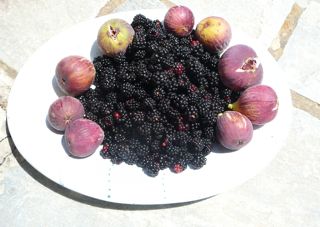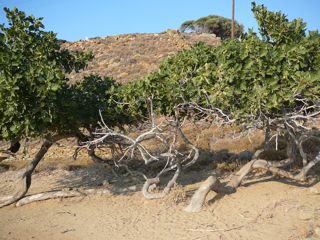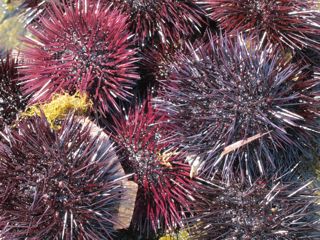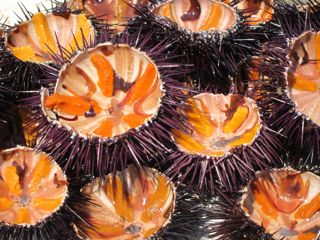“And The Livin’ Is Easy”
Eating Well Is The Best Revenge
by Diana Farr Louis
ANDROS, GREECE—(Weekly Hubris) —(8/16/10)—You may have read about Greece’s ongoing problems this summer—a truckers’ strike, slowdowns at airports, stranded cruise boat passengers—as workers wrangle with government and IMF reforms. But, on this island, there is no sign of any crisis at all. Ferries come and go without a halt, SUV’s stream off them as from an assembly line, and taverna waiters are rushed off their feet, serving the sun-baked and salt-encrusted from noon to midnight.
This is the country’s holiday month, and one has the sense that Greeks are not going to let any doom and gloom scenario blight their vacations. Greece has always had a Scarlett-O’Hara-“tomorrow is another day” attitude, so we’ll save the belt-tightening for later. This may be our Last Hurrah, but it will be a good one.
As for me, I’m deep into my annual summer sloth mode. Although the days stretch from 8 a.m. till well past normal bedtimes, there don’t seem to be enough hours to do anything but swim, eat and take long naps. The IHT and Guardian Weekly accumulate sloppily on chairs, only partly read but too precious to discard. I’ve had the same book by my bedside for weeks. You couldn’t say I’m busy house cleaning or even cooking much. So where does the time fritter away to?
While “Joy of the People” (Harilaos, my husband) is out morning and evening watering trees, digging up thistle patches or painting pergola beams—generally keeping house and land presentable, indefatigably—I am a slave to nature.
The plum season having finished at last, I’ve moved on to tomatoes. At least once a week, following an Italian friend’s example, I halve and salt the smaller ones, and set them on foil-lined trays to dry in the sun. After just a few days, when they’re almost stiff, I bottle them in oil along with a few basil leaves. Tomato-essence chewing gum they may be, but too good to give away. The larger ones I turn into a spicey, garlicky chutney, in big batches that make the jars easier to part with.
Meanwhile, August brings other obligations. The blackberries next door—a wild plot owned by friends who haven’t got around to building yet—demand picking. So, once a week, I abandon shorts for jeans and, armed with a shepherd’s crook and bowl, plunge into battle. The thorns always scratch, fingernails remain purple for days, the plumpest fruit is always out of reach, but those crumbles and jams are worth suffering for.
Then there are the figs. I’m of the persuasion that no fig should die a natural death. Since sections of the main road into town are lined with wild fig trees, my rule must bend to reason, so I limit myself to our own trees and those growing out of the sand near our favorite beach.
These poor twisted creatures are savaged by feral goats, which have been known to climb onto our car to get at the higher leaves, never mind the fruit. Their elephantine trunks and boa-like branches sprawl over the sand in a tangle that betrays a surprising cache of water deep below. The whole scene is one of nature’s miracles.
But a visit to that beach means a session of fig picking, either before or after a swim. Figs for eating right then, figs for breakfast, for a winy compote, and for drying—like tomatoes—on the terrace. I’ve given up on jams and chutneys, as being too sweet.
Foraging doesn’t stop on land, though. There are also sea urchins to harvest. This is a serious business, requiring special equipment: besides mask, snorkel and flippers, one needs a net bag or basket for collecting them and a “coupe-oursins.” This item, invented by the French, of course, resembles the effete device that people such as King Farouk used to decapitate soft-boiled eggs. We pry the prickly creatures off their rocks with the tip and slice them in half with curved blades that come together like a double guillotine to reveal their five segments of indescribably delicious orangey-yellow eggs. Sqeamish men watching this operation call the tool “cojones cutters,” and keep their distance.
Diving for sea urchins is an atavistic pleasure that takes me back to the 60’s and my first summers on Spetses. Our mornings there had a repetitive pattern we never tired of. Around 11 o’clock, my new Greek family and friends would scramble onto a caique that would chug-chug us to one of many special coves. The best had pink-violet grottoes, flat rocks and the fattest spiny prey on the island. As soon as we anchored, we’d plunge in with knives and baskets and begin the hunt.
I soon learned which urchins to choose and how to scoop them into my basket without ending up like a pincushion. Then I could devote myself to the exquisite enjoyment of the undersea world in the embrace of the warm, clear Aegean, so different from the great grey greasy Atlantic of my childhood.
But if the collecting of our hors d’oeuvres was a form of solitary hedonism, the real pleasure came in preparing them and devouring them among company. If breaking bread together makes for companionship, think what bonds are forged by the ritual of cutting, cleaning and sharing a mountain of caviar-producing shellfish.
The whole party would gather on the scorching rock, watching greedily as we’d laboriously slice through prickles (no coupe-oursins in those days) and rinse the insides to expose those radiant stars. As we worked, we’d remind ourselves that sea urchins cost 5 francs (about a dollar) apiece in Paris. Making our daily feast a luxury only millionaires could afford.
But in Paris we would have had spoons, lemons and etiquette, while here we were, practically naked, gobbling them right from the sea. Lifting each segment from shell to lips with a finger or thumb. Savoring each mouthful and noticing the subtle variations in flavor. Lemon would have made each urchin taste the same.
What do they taste like? A distillate of sea, with a touch of pine, salt, sun. Not fishy, not slimy.
Most of all, to me so many years later, they taste of memories, carefree sun-baked Augusts in the company of adored relatives and friends. One bite and I’m back on Spetses, in that brave new world that so beguiled me. But, at the same time, whenever I perform these rituals, they never fail to create an atmosphere of blissful “now-ness”—gratifying all the senses and bringing smiles from ear to ear.
For me and my extended family, eating sea urchins on the beach is the quintessence of a Greek summer. And you can be sure no crisis can change that. Sometimes the best things in life are indeed free.
Sea urchin photos by Petros Ladas, who has loved them since the age of one.





3 Comments
Eleni Kasimati
Hi Dianaki!!
I like your article a lot. But because I can’t write so much with a lot of words ,I will just give you some words that come out in me after reading your text.
Refreshment, good life is simple, Greek nostalgia, nice photos, seeing the good side of life as a contradiction to all bad things we hear and live lately, enjoying is bright, is refreshing others. Live now and stay in present.
I love the way you bring into your writing the how much you enjoy your life.
Bravo!!
Eleni Kasimati
Ah! I forgot to say that the 16th of August is my birthday, so your article is like a little present to me!!
diana farr louis
Elenaki mou,
F Harry Stowe for your wonderful comment. A real present to me and it’s not even my birthday. Chronia Polla & Kala!